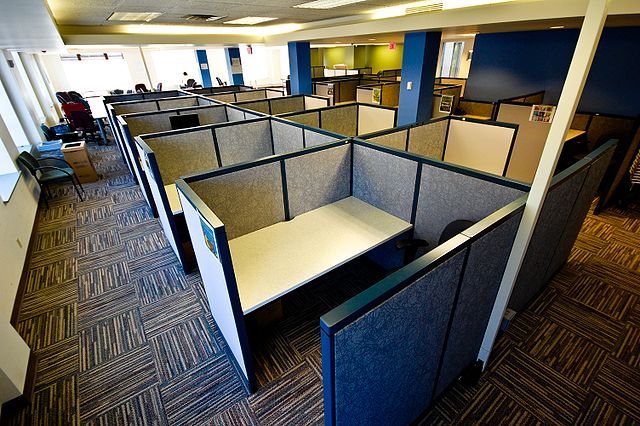Image by Asa Wilson
Whether you have a bustling workplace or your own private cubicle, you may not realise how much your workflow is affected by those around you. But with many companies moving in opposite directions, it’s time to investigate which layout is really best.
Open Plan or Cubicle?
Facebook recently disclosed that its new Californian headquarters would be “the largest open floor plan in the world”, with in excess of 3,000 people working on moveable furniture that will span across 10 acres, but is an open plan office really best for productivity?
Robert Zajonc’s studies in the fields of social facilitation and social inhibition may offer some clues; social facilitation is the tendency for the presence of others to assist an individual’s performance, while social inhibition is the tendency for their presence to inhibit it. In 1965 Zajonc claimed that well-learned behaviours are performed more successfully in the presence of others, while new tasks prove more difficult. This is due to the presence of an audience creating arousal, which occurs regardless of whether those present are actually paying attention.
Some researchers have extended this theory to the working environment, by theorising about the effect of Zajonc’s claims in open-plan office designs (Eliiot & Cohen, 1981). According to this research the removal of personal space leads to increased arousal, inhibiting complex task performance. Paulus and Nagar’s 1989 research further supports this theory, adding that the level of inhibition may increase with the density of the crowding. Therefore busier offices would lead to higher levels of arousal and lower levels of complex productivity.
However, it appears that the effects produce by this sense of crowding can be diminished by clever architectural designs. Paulus and Nagar recommend using private spaces, office dividers, high ceilings and large windows to prevent the sense of crowding, while Langer & Saegert (1977) suggest that flexible spaces may give people a greater sense of freedom. Spatial structure can therefore alter perception.
But in spite of this solution, open-plan offices also risk alienating their employees. Architecture editor Karsten Ifversen recently stated that open plan offices are more likely to make an employee feel dispensable, particularly if they contain flexible working spaces that can be adapted for a variety of needs. So to help build trust and loyalty to a company, personalised spaces may also be necessary.
Does It Matter Where the Boss Sits?
If other employees can create a heightened level of arousal, inhibiting complex task analysis, would an overseeing boss have a similar effect?
Gore & Taylor’s 1973 experiment showed that expert spectators inhibit learning even further than non-experts. This is particularly the case when the observer is aware of the performer’s previous abilities and the reaction intensifies in relation to the observer’s unfamiliarity to the participant. However, this only applies if the spectator is attentive (Guerin 1983), so unless the boss was paying attention it wouldn’t make a difference.
Therefore an overseeing unfamiliar boss could help to maximise productivity with familiar tasks, but only so long as they were seen to be paying attention, rather than just working at their desk.
Do People Work Better Sat in Teams?
Some offices choose to sit people together that do similar tasks, while others prefer a more diverse spread of abilities, but which is really more effective?
Back in 1994 O’Hara Devereaux and Johansen claimed that virtual teams could not work as effectively as those who work face-to-face, due to their inability to replicate the ‘water-cooler’ information channels, leading to missed non-verbal cues. Indeed, in 1991 Kiesler et al argued that electronic communications are dehumanising and create a sense of social anonymity; messages therefore tend to be less polite as people feel less accountable for their actions. This can lead to a lack of trust. However, with recent technological developments in the world of video-conferencing, virtual exchanges can now be extremely lifelike, so perhaps there is no longer a risk of missing these non-verbal cues. E-mail exchanges however still carry these risks.
However, while seating employees in teams can give them a sense of security and build up their trust, it can also lead to social loafing, with all members reducing their individual output due to the increased members of the team; if an individual believes that their actions won’t affect the group as a whole, they will be more likely to reduce their effort. Therefore while it can be useful to have collaborative work spaces, employees should also be given their own individual tasks and space, in order to make them feel valued and aware that the work they produce is important. Pixar’s Californian studios use this principal to great effect, with employees based in their own work pods, but with group work spaces easily accessible.
Thus while open plan offices may aid collaboration and lead to better performance on simple tasks, they can also inhibit learning, reducing an employee’s complex work output. Therefore there is no universally perfect workplace design as it will always be relative to a company’s needs. If employees are performing well-learned tasks all day, or a large amount of collaboration is essential, then open-plan offices can work well. However, in most companies employees will benefit from having their own space, even if that space is largely imagined due to architecture or partitions that reduce the sense of crowding.
Which layout does your office favour?


